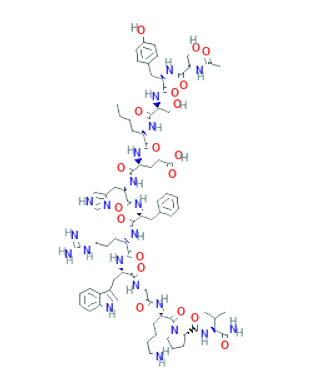Compound Overview
Class of Compound
Peptide
Mechanism of Action
Melanotan I is an agonist of melanocortin receptors 1, 3, 4, and 5, binding primarily to melanocortin receptor 1 to trigger melanin production.
Notable Studies
- Increased eumelanin expression and tanning is induced by a superpotent melanotropin [Nle4-D-Phe7]-alpha-MSH in humans
- Effects of a superpotent melanotropic peptide in combination with solar UV radiation on tanning of the skin in human volunteers
- A phase II, randomised, open label pilot study to evaluate the efficacy and safety of two dosage regimens of subcutaneous bioresorbable afamelanotide implants in patients with mild to moderate acne vulgaris
Also Known As
afamelanotide, afamelanotide acetate, afamelanotide triacetate, Melanotan-1, MT-1, 1566590-77-9, CUV-1647, CUV1647 ACETATE, CHEMBL4297213, A-melanotropin, 4(nle)-7(d-phe), 75921-69-6, Scenesse
Research Applications
- Skin tanning
- Skin diseases
- Erectile dysfunction
Risks
- Limited official approval
- Mild
- Administration-related symptoms
- Many counterfeits online
Chemical Structure

What is Melanotan I?
Melanotan is a synthetic analogue of alpha-melanocyte-stimulating hormone, or α-MSH for short. α-MSH is one of a number of melanocortin peptide hormones in the body [1]. Melanotan is typically injected or administered as an implant and binds to melanocortin receptors 1, 3, 4, and 5.
There are two types of melanotan molecules: melanotan I and melanotan II. They have both been linked to increased melanin production and increased tanning of the skin [2, 3, 4, 5, 6, 7].
While there is strong research interest in both melanotan molecules, this review will focus on melanotan I.

What Does Melanotan I Do?
Melanotan I ([Nle-D-Phe]-α-MSH) is a synthetic peptide that has a linear formation. It is 13 amino acids in length and has the same structure as α-MSH save for two key differences. First, the fourth amino acid in melanotan I is norleucine; second, the seventh amino acid is D-phenylalanine [5].
In the body, melanotan I primarily binds with the MC1R receptor and is more potent and resistant to breakdown than α-MSH [7]. Studies have shown that MT-1 significantly enhances tanning and reduces sunburn [4].
Melanotan I should not be confused with melanotan II (Ac-Nle-[Asp-His-D-Phe-Arg-Trp-Lys]- α-MSH-NH2). MT-2 is less receptor-specific than melanotan I and has been linked to more side effects. Studies have shown that melanotan II increases libido and decreases appetite to a greater extent than MT-1 [6].
Melanotan I Benefits | Clinical Trials
A number of clinical trials have evaluated the safety and efficacy of melanotan I, from which the following benefits can be drawn.
Increased melanin production and rate of tanning
Melanotan I binds to the melanocortin 1 receptor (MC1R), thereby increasing melanin production. This has the secondary effect of increasing levels of the enzyme tyrosinase and melanocyte [2, 3]. Studies have found that MT-1 can increase the rate of tanning and reduce the number of sunburnt cells in test subjects [4].
Three phase I clinical trials conducted by dermatology clinics at the Arizona Health Sciences Center have investigated two dose levels of melanotan I combined with small doses of UV-B to the neck or buttock, or full sunlight to half of the back. In these trials, test subjects receiving melanotan I had 47% fewer sunburn cells on their neck and “significantly enhanced tanning” on their back compared with the control group [4].
Improved mood and outlook
Results from several phase II clinical trials sponsored by Clinuvel Pharmaceuticals have shown that melanotan I offers psychological benefits including improved mood and outlook in patients who had received photodynamic therapy (PDT), a treatment that uses light and photosensitization to kill cancer cells [5].
A 2008 phase II multicentre, double-blind, placebo controlled pilot study aimed to evaluate whether melanotan I implants (referred to in the study as afamelanotide implants) could reduce the period of phototoxicity experienced by patients who have undergone photodynamic therapy with porfimer sodium.
Based on findings from 16 patients who received study treatment (9 MT-1, 7 placebo), patients treated with melanotan I experienced positive changes in their mood and mental health compared to placebo [8]. A secondary effect was reduced pain, which could have resulted in these changes.
A second follow-up trial was started in the same year and aimed to evaluate the safety of subcutaneous bioresorbable implants of CUV1647 (melanotan I). Results for this trial are not available [9].
Potential acne treatment
Melanotan I has been investigated as a potential treatment for acne vulgaris. In 2011 a phase II randomized study was conducted in Germany to evaluate the efficacy and safety of two dosage regimens of subcutaneous bioresorbable afamelanotide implants in patients with mild to moderate acne vulgaris [10].
The study found that test subjects treated with melanotan I (either three injections at 3-week intervals, or two injections at 4-week intervals) experienced a decline in the number of inflammatory acne lesions on their faces. Researchers also found that quality of life as measured by DLQI improved in all patients from day 0 to day 56 and patients treated with melanotan I were able to spend up to seven times longer in direct sunlight without experiencing pain [10].
Another phase II randomized pilot study that aimed to evaluate the same melanotan I implant and narrow-band ultraviolet B (NB-UVB) light was also published in 2011. Results for this trial are not available [11].
Potential treatment for xeroderma pigmentosum
Melanotan I has been investigated as a treatment for xeroderma pigmentosum (XP), an inherited condition characterized by extreme sensitivity to ultraviolet (UV) light. In 2019, a proof of concept, phase IIa open label study in Germany aimed to evaluate the safety and efficacy of melanotan I implants in patients with XP [12]. Another phase IIa study was started in 2021 and is currently ongoing [13].
Potential treatment for polymorphic light eruption
A 2010 phase III, randomized, double blind, placebo controlled, parallel group study was undertaken in Germany, the Netherlands, and Belgium to evaluate the safety and efficacy of subcutaneous implants of melanotan I (16 mg) in patients suffering from polymorphic light eruption (PLE), a condition characterized by a rash following exposure to sunlight.
Researchers found that melanotan I could reduce the severity of PLE related pruritus when administered as 16 mg implants over a period of 4 months [14].
Potential treatment for erythropoietic protoporphyria
A 2011 phase III study in Europe aimed to confirm the safety and efficacy of subcutaneous bioresorbable melanotan I implants in patients with Erythropoietic Protoporphyria (EPP). The study aimed to determine whether 16 mg melanotan I implants could improve the quality of life of EPP patients. Researchers found that test subjects in the melanotan I group experienced less pain and a higher quality of life compared with those in the placebo group [15].
Buy Melanotan 1 from our top-rated vendor...

Melanotan Side Effects
Based on findings from clinical studies, melanotan I appears to have a favorable safety profile. There have been no reported safety concerns, no significant drug-related adverse events, no deaths, and no adverse events leading to discontinuation of a study [8, 9, 10, 11, 12, 13, 14, 15].
Based on the research, the only side effects linked to melanotan I are:
Is Melanotan I Safe?
Melanotan I is a research chemical and has no safe or recommended dosage. While data from clinical studies suggests that this peptide has a positive safety profile, there are several cases reported in the literature to show why experimentation with this peptide is limited to in vitro experimentation only [16].
Cousin et al. described a case of eruptive melanocytic naevi following melanotan I injection [17];
Evans-Brown et al. described the potentially harmful effects of melanotan I and melanotan II [18];
According to Langan et al. melanotan I use has been linked to changes in moles [19];
Dreyer et al. described a case of melanotan-induced priapism [20].
In summary, administration of melanotan I is restricted to clinicians and researchers.
Melanotan I Dosage Calculator
For tanning of the skin, research suggests a melanotan I dosage range of 0.25mg to 2mg a day. It is advisable to start at the lowest possible dose, before increasing to achieve the desired outcome.
Researchers interested in studying the potential of melanotan I to treat a variety of skin disorders may consult the above-cited clinical trials to gain a fuller understanding of how this peptide has been dosed.
Melanotan 1 dosages ranging from 0.08mg/kg to 0.16mg/kg per day were implemented in phase I studies in Europe. The phase II and III European studies involved 16mg melanotan I implants for a treatment period of up to four months [8, 9, 10, 11, 12, 13, 14, 15].

Where to Buy Melanotan 1 Online? | 2024 Edition
Researchers interested in investigating melanotan 1 will find that this research chemical is available online from a number of vendors.
The difficulty lies in sourcing research-grade preparations in a reliable and timely manner.
In our team’s experience, the best place to buy melanotan 1 online is Xcel Peptides. Here's why:
Xcel Peptides
Here are the reasons why Xcel Peptides has become our go-to vendor of melanotan 1 and other research peptides:
- Open and Transparent: While many vendors claim to sell legitimate melanotan 1, Xcel Peptides actually has each batch tested by a third-party lab. The vendor posts these lab results online, letting researchers verify the purity of the peptide prior to making a purchase.
- Great Prices: Xcel Peptides sells melanotan 1 7.5mg vials for just $29 each. Researchers can save an additional 10% when they sign up for the vendor's email list.
- Fast Shipping: Shipping within the U.S. takes 2-3 business days, while orders over $200 ship free and even qualify for a complementary vial of bacteriostatic water.
- Knowledgeable Service: Researchers who have questions about any aspect of buying melanotan 1 online should receive a knowledgeable response to their email inquiry within 24 hours.
Overall, Xcel Peptides is our recommended vendor and will not disappoint.
Buy research peptides from Polaris Peptides today...

Bacteriostatic Water and Melanotan 1
Leading peptide researchers know the importance of proper supplies when safely handling Melanotan I.
To effectively include peptides in the research, a lab should be stocked with bacteriostatic water and alcohol prep pads, in addition to other essentials.
Generally, a researcher will need to acquire these supplies when conducting study on peptides like melanotan 1:
- Bacteriostatic Water
- Insulin Syringes
- Large Needles + Syringes
- Alcohol Prep Pads
- Sterile Empty Glass Vial
For researchers who do not have the required materials and supplies in the lab, checking with authorized sources to procure said products is required.
FAQ
Melanotan One | Reviews
Apart from its well-known use as a sunless tanning agent, melanotan I is being actively investigated as a treatment of a variety of skin disorders. In clinical studies, it has been shown to reduce sunburn cells, pain in photodynamic therapy patients, and inflammatory acne lesions in patients with mild to moderate acne vulgaris.
Researchers interested in further exploring melanotan I will note that this peptide has a favorable safety profile and has not been linked to any serious adverse effects in test subjects.
If you are looking to order melanotan I for research purposes, head over to our preferred vendor here.
References
- Mahiques-Santos L. Melanotan [Melanotan]. Actas Dermosifiliogr. 2012 May;103(4):257-9. Spanish. doi: 10.1016/j.ad.2011.08.002. Epub 2011 Nov 1. PMID: 22051769.
- Hadley ME, Dorr RT. Melanocortin peptide therapeutics: historical milestones, clinical studies and commercialization. Peptides. 2006 Apr;27(4):921-30. doi: 10.1016/j.peptides.2005.01.029. Epub 2006 Jan 18. PMID: 16412534.
- Dorr RT, Dvorakova K, Brooks C, Lines R, Levine N, Schram K, Miketova P, Hruby V, Alberts DS. Increased eumelanin expression and tanning is induced by a superpotent melanotropin [Nle4-D-Phe7]-alpha-MSH in humans. Photochem Photobiol. 2000 Oct;72(4):526-32. doi: 10.1562/0031-8655(2000)072<0526:ieeati>2.0.co;2. PMID: 11045725.
- Dorr RT, Ertl G, Levine N, Brooks C, Bangert JL, Powell MB, Humphrey S, Alberts DS. Effects of a superpotent melanotropic peptide in combination with solar UV radiation on tanning of the skin in human volunteers. Arch Dermatol. 2004 Jul;140(7):827-35. doi: 10.1001/archderm.140.7.827. PMID: 15262693.
- Wikberg JE, Muceniece R, Mandrika I, Prusis P, Lindblom J, Post C, Skottner A. New aspects on the melanocortins and their receptors. Pharmacol Res. 2000 Nov;42(5):393-420. doi: 10.1006/phrs.2000.0725. PMID: 11023702.
- Ryakhovsky VV, Khachiyan GA, Kosovova NF, Isamiddinova EF, Ivanov AS. The first preparative solution phase synthesis of melanotan II. Beilstein J Org Chem. 2008;4:39. doi: 10.3762/bjoc.4.39. Epub 2008 Oct 30. PMID: 19043625; PMCID: PMC2587946.
- Ugwu SO, Blanchard J, Dorr RT, Levine N, Brooks C, Hadley ME, Aickin M, Hruby VJ. Skin pigmentation and pharmacokinetics of melanotan-I in humans. Biopharm Drug Dispos. 1997 Apr;18(3):259-69. doi: 10.1002/(sici)1099-081x(199704)18:3<259::aid-bdd20>3.0.co;2-x. PMID: 9113347.
- A Phase II, Multicentre, Double-blind, Placebo Controlled, Pilot Study to Evaluate the Safety and Efficacy of CUV1647 Administered as A Subcutaneous Bioresorbable 16mg Implant in Patients Undergoing Photodynamic Therapy (PDT) utilising Porfimer Sodium – Results. (2020). Retrieved 14 May 2022, from https://www.clinicaltrialsregister.eu/ctr-search/trial/2008-002446-39/results
- A Multicentre, Randomised, Double-Blind, Placebo-Controlled Phase II Study to Evaluate the Safety and Efficacy of Subcutaneous Bioresorbable Implants of CUV1647 for the Prophylactic Treatment of Pr... (2020). Retrieved 14 May 2022, from https://www.clinicaltrialsregister.eu/ctr-search/search?query=2007-007015-89
- A Phase II, Randomised, Open Label Pilot Study to Evaluate the Efficacy and Safety of Two Dosage Regimens of Subcutaneous Bioresorbable Afamelanotide Implants in Patients with Mild to Moderate Acne Vulgaris. (2021). Retrieved 14 May 2022, from https://www.clinicaltrialsregister.eu/ctr-search/trial/2009-018024-15/results
- A Phase II, Randomised Pilot Study to Evaluate the Efficacy and Safety of Subcutaneous, Bioresorbable Afamelanotide Implants and Narrow-Band Ultraviolet B (NB-UVB) Light in the Treatment of Nonsegm... (2011). Retrieved 14 May 2022, from https://www.clinicaltrialsregister.eu/ctr-search/search?query=2011-000169-10
- A Phase III, randomised, double blind, placebo controlled, parallel group study, to evaluate the safety and efficacy of subcutaneous implants of afamelanotide (16 mg) in patients suffering from polymorphic light eruption (PLE). (2022). Retrieved 14 May 2022, from https://www.clinicaltrialsregister.eu/ctr-search/search?query=2009-017359-92
- A Proof of Concept, Phase IIa, Open Label Study to Evaluate the Safety and Efficacy of Subcutaneous Implants of Afamelanotide in Patients with Xeroderma Pigmentosum (XP). (2019). Retrieved 14 May 2022, from https://www.clinicaltrialsregister.eu/ctr-search/search?query=2019-000597-34
- A Proof of Concept, Phase IIa, Open Label Study to Evaluate the Safety and Efficacy of Subcutaneous Implants of Afamelanotide in Patients with Xeroderma Pigmentosum (XP). (2021). Retrieved 14 May 2022, from https://www.clinicaltrialsregister.eu/ctr-search/search?query=2021-003642-20
- A Phase III, Multicentre, Double-Blind, Randomised, Placebo-Controlled Study to Confirm the Safety and Efficacy of Subcutaneous Bioresorbable Afamelanotide Implants in Patients with Erythropoietic Protoporphyria (EPP). (2020). Retrieved 14 May 2022, from https://www.clinicaltrialsregister.eu/ctr-search/search?query=2009-011018-51
- Langan EA, Nie Z, Rhodes LE. Melanotropic peptides: more than just 'Barbie drugs' and 'sun-tan jabs'? Br J Dermatol. 2010 Sep;163(3):451-5. doi: 10.1111/j.1365-2133.2010.09891.x. Epub 2010 Jun 9. PMID: 20545686.
- Cousen P, Colver G, Helbling I. Eruptive melanocytic naevi following melanotan injection. Br J Dermatol. 2009 Sep;161(3):707-8. doi: 10.1111/j.1365-2133.2009.09362.x. Epub 2009 Jul 2. PMID: 19575725.
- Evans-Brown M, Dawson RT, Chandler M, McVeigh J. Use of melanotan I and II in the general population. BMJ. 2009 Feb 17;338:b566. doi: 10.1136/bmj.b566. PMID: 19224885.
- Langan EA, Ramlogan D, Jamieson LA, Rhodes LE. Change in moles linked to use of unlicensed "sun tan jab". BMJ. 2009 Jan 27;338:b277. doi: 10.1136/bmj.b277. PMID: 19174439.
- Dreyer BA, Amer T, Fraser M. Melanotan-induced priapism: a hard-earned tan. BMJ Case Rep. 2019 Feb 21;12(2):e227644. doi: 10.1136/bcr-2018-227644. PMID: 30796078; PMCID: PMC6388891.
